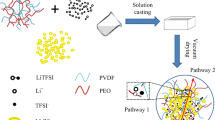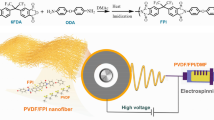Abstract
Polyvinylidene fluoride (PVDF) is composited into electrolyte material, e.g., LaCePr-oxide-La0.6Sr0.4Co0.2Fe0.8O3-δ (LCP-LSCF), to improve its electrochemical performance and enhance its mechanical strength for a low-temperature solid oxide fuel cell. The influence of different PVDF contents on the performance of the as-prepared samples was studied in this work. X-ray diffraction results indicate that there is no impurity phase in the composite. Thermogravimetric analysis and differential scanning calorimetry were employed to investigate the composite’s stability at operating temperature. The I–V and I–P characteristics indicate that the microstructures of the nanocomposites that can be controlled by PVDF which plays an important role in its electrochemical performance. The cell with 3 wt% PVDF that was heat treated at 210 °C achieved the highest power density of 687 mW cm−2 at 550 °C, which was 196 mW cm−2 higher than that without any heat treatment. The pores are formed by PVDF, and the heat treatment enlarged the triple-phase boundary (TPB), which was the main reason for improved performance.






Similar content being viewed by others
References
Z. Gao, L.V. Mogni, E.C. Miller, J.G. Railsback, S.A. Barnett, A perspective on low-temperature solid oxide fuel cells. Energy Environ. Sci. 9, 1602–1644 (2016)
L.D. Fan, B. Zhu, P.C. Su, C.X. He, Nanomaterials and technologies for low temperature solid oxide fuel cells: Recent advances, challenges and opportunities. Nano Energy 45, 48–176 (2018)
C.C. Duan, D. Hook, Y.C. Chen, J.H. Tong, R. O’Hayre, Zr and co-doped perovskite as a stable, high performance cathode for solid oxide fuel cells operating below 500 degrees C. Energy Environ. Sci. 10, 176–182 (2017)
L. Fan, P.C. Su, Layer-structured LiNi0.8Co0.2O2: a new triple (H+/O2−/e−) conducting cathode for low temperature proton conducting solid oxide fuel cells. J. Power Sources 306, 369–377 (2016)
G. Chen, Y.D. Luo, W.K. Sun, H.L. Liu, Y.S. Ding, Y. Li et al., Electrochemical performance of new structured low temperature SOFC with BZY electrolyte. Int. J. Hydrogen Energy 43, 12765–12772 (2017)
Y.Z. Lu, Y.X. Cai, L. Souamy, X. Song, L. Zhang, J. Wang, Solid oxide fuel cell technology for sustainable development in China: an over-view. Int. J. Hydrogen Energy 43, 12870–12891 (2018)
Y. Luo, Y. Li, N. Zhang, Y. Ding, H. Li, G. Chen, Electrical properties and chemical stability of Br addition in BaCe0.8Gd0.2O3-α proton-conducting electrolyte. Ceram. Int. 46(16), 26027–26034 (2020)
E.C.H. Sreele, Interfacial reactions associated with ceramic ion transport membranes. Solid State Ionics 75, 157–165 (1995)
H. Nomura, S. Parekhm, J.R. Selman et al., Fabrication of YSZ electrolyte for intermediate temperature solid oxide fuel cell using electrostatic spray deposition: II-Cell performance. J. Appl. Electrochem. 35, 1121–1126 (2005)
C. Ding, T. Hashidam, High performance anode-supported solid oxide fuel cell based on thin-film electrolyte and nanostructured cathode. Energy Environ. Sci. 3, 1729–1731 (2010)
M. Mogensen, N.M. Sammea, G.A. Tompsett, Physical, chemical and electrochemical properties of pure and doped ceria. ChemInfrom 31, 63–94 (2000)
T. Matsui, T. Kosaka, M. Inaba et al., Effects of mixed conduction on the open-circuit voltage of intermediate-temperature SOFCs based on Sm-doped ceria electrolytes. Solid State Ion. 176, 663–668 (2005)
G. Chen, W.K. Sun, Y.D. Luo, Y. He, X.B. Zhang, B. Zhu, W.Y. Li et al., Advanced fuel cell based on new nanocrystalline structure Gd0.1Ce0.9O2 electrolyte. ACS Appl. Mater. Interfaces. 11, 10642–10650 (2019)
G. Chen, H.L. Liu, Y. He, L.L. Zhang, M. Asghar, S.J. Geng, D. Lund, Electrochemical mechanisms of an advanced low-temperature fuel cell with SrTiO3 electrolyte. J. Mater. Chem. A 7, 9638–9645 (2019)
G. Chen, B. Zhu, H. Deng, Y.D. Luo, W.K. Sun et al., Advanced fuel cell based on Perovskite La-SrTiO3 semiconductor as the electrolyte with super oxide-ion conduction. ACS Appl. Mater. Interfaces. 10, 33179–33186 (2018)
G. Chen, Y.D. Luo, W.K. Sun, H.L. Liu, Y.S. Ding, Y. Li, Electrochemical performance of a new structured low temperature SOFC with BZY electrolyte. Int. J. Hydrogen Energy 43, 12765–12772 (2018)
B. Zhu, Y. Ma, X. Wang, R. Raza, H. Qin, L. Fan, A fuel cell with a single component functioning simultaneously as the electrodes and electrolyte. Electrochem. Commun. 13, 225–227 (2011)
B. Zhu, Fuel cells:three in one. Nat. Nanotechnol. 6, 330 (2011)
B. Zhu, R. Raza, H. Qin, Q. Liu, L. Fan, Fuel cells based on electrolyte and non-electrolyte separators. Energy Environ. Sci. 4, 2986–2992 (2011)
B. Zhu, R. Raza, H. Qin, L. Fan, Single-component and three-component fuel cells. J. Power Sources 196, 6362–6365 (2011)
B. Zhu, H. Qin, R. Raza, Q. Liu, L. Fan, J. Patakangas, P. Lund, A single-component fuel cell reactor. Int. J. Hydrogen Energy 36, 8536–8541 (2011)
B. Zhu, L. Fan, P. Lund, Breakthrough fuel cell technology using ceria-based multi-functional nanocomposites. Appl. Energy 106, 163–175 (2013)
B. Zhu, L. Fan, Y. Zhao, W. Tan, D. Xiong, H. Wang, Functional semiconductor-ionic composite GDC-KZnAl/LiNiCuZnOx for single-component fuel cell. RSC adv. 4, 9920–9925 (2014)
B. Zhu, B. Wang, Y. Wang, R. Raza, W. Tan, J. Kim et al., Charge separation and transport in La0.6Sr0.4Co0.2Fe0.8O3-δ and ion-doping ceria hetero-structure material for new generation fuel cell. Nano Energy 37, 195–202 (2017)
Y. Wu, B. Zhu, M. Huang, L. Liu et al., Proton transport enabled by a field-induced metallic state in a semiconductor heterostructure. Science 369(6500), 184–188 (2020)
G. Chen, W.K. Sun, Y.D. Luo, H.L. Liu, S.J. Geng, K. Yu, G.Q. Liu, Investigation of layered Ni0.8Co0.15Al0.05LiO2 in electrode for low-temperature solid oxide fuel cells. Int. J. Hydrogen Energy 43, 417–425 (2018)
Z. Zhen, Characteristic of polyvinylidene fluoride and its application in process industry. Corr. Sci. Technol. Protect. 16, 118–120 (2004)
Z. Qiao, C. Xia, Y. Cai, M. Afzal, H. Wang, J. Qiao, B. Zhu, Electrochemical and electrical properties of doped CeO2-ZnO composite for low-temperature solid oxide fuel cell applications. J. Power Sources 392, 33–40 (2018)
L. Fan, H. Zhang, M. Chen et al., Electrochemical study of lithiated transition metal oxide composite as symmetrical electrode for low temperature ceramic fuel cells. Int. J. Hydrogen Energy 38, 11398–11405 (2013)
L. Fan, P.C. Su, Layer-structured LiNi0.8Co0.2O2: a new triple (H+/O2−/e−) conducting cathode for low temperature proton conducting solid oxide fuel cells. J. Power Sources 306, 69–377 (2016)
B. Zhu, Y. Huang, L. Fan et al., Novel fuel cell with nanocomposite functional layer designed by perovskite solar cell principle. Nano Energy 19, 156–164 (2016)
J. Zhu, H. Deng, B. Zhu, W.J. Dong, W. Zhang, J.J. Li, X.J. Bao, Polymer-assistant ceramic nanocomposite materials for advanced fuel cell technologies. Ceram. Int. 43, 5484–5489 (2017)
Acknowledgements
This work is supported by the Natural Science Foundation of Jiangsu Higher Education Institutions of China (Grant Nos. 17KJB120003; 19KJB480010). This work is also partly supported by the Natural Science Foundation of Nanjing Xiaozhuang University (Grant No. 2020NXY12), and the Foundation of Jinling Institute of Technology (Grant Nos: jit-fhxm-201607 and jit-b-201706), the foundation of Jiangsu province modern education research (Grant No. 2019-R-80918), the Education Reform Project of Jinling Institute of Technology (Grant No. KCSZ2019-5).
Author information
Authors and Affiliations
Corresponding author
Additional information
Publisher's Note
Springer Nature remains neutral with regard to jurisdictional claims in published maps and institutional affiliations.
Rights and permissions
About this article
Cite this article
Lu, Y., Zhang, K., Li, J. et al. A novel polymer-ceramic composite low-temperature solid oxide fuel cells. J Mater Sci: Mater Electron 32, 1918–1927 (2021). https://doi.org/10.1007/s10854-020-04960-w
Received:
Accepted:
Published:
Issue Date:
DOI: https://doi.org/10.1007/s10854-020-04960-w




